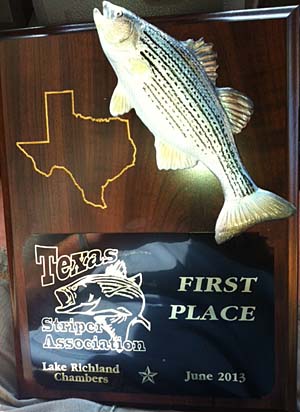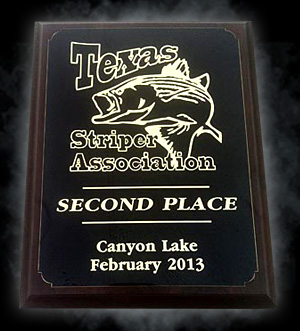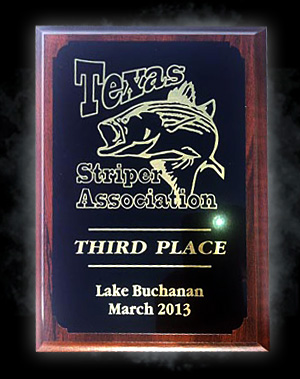Inks Lake Fishing

Inks Lake Fishing
By Robbis Storm
From 50 yards away you could see the long fishing rod bending and bucking like a well-spurred rodeo bronc. As you walked up closer, you began to hear the off-and-on whines of a spinning reel, screaming under pressure. Then you saw the angler’s face and you knew instantly — this was no ordinary fish.
We were standing on the banks of the upper reaches of Inks Lake not far below the big dam which impounds Lake Buchanan, the jumbo Highland Lake just upstream from Inks. It was late winter, the season when white bass begin staging for the spring spawning run. This time of year the whites (or “sand bass” as some folks call them) stack up below dams where they’re in easy reach of bank fishermen.
In fact it was at this same spot over 50 years ago that I caught my very first white bass. It was a January afternoon. The skies were gray and the wind out of the north had a bite to it. But I was an adolescent, excited to be casting my first fishing rod, and in my excitement and youth, I didn’t feel the cold at all. I made cast after cast into the rolling tailrace water. Finally I had a hit, set the hook, and the fight was on. The same fish today would seem ordinary, but to a 12-year-old, a 15-inch white bass on light tackle in swift water felt more like a marlin than a panfish. I think three sandies succumbed to my Abu Reflex spinner before it got too dark to fish. At any rate I was hooked on white bass — and still am.
And Inks is still a good lake for white bass — and lots of other fish too. Unlike Lake Buchanan, Inks Lake is a constant level lake, which means that aquatic vegetation has a better chance to grow, giving largemouth bass some shoreline cover. And at least one cove of Inks is filled with standing timber — more good cover for structure-loving largemouths. If you’re after black bass, Guide Jackie Headrick, who fishes Inks regularly, recommends fishing plastic worms and top water baits around boat docks. Inks has produced some very high quality bass including the lake record largemouth caught by Stephen Mallett in 2001. Mallett’s lunker came in the tiniest tad under 12 pounds and lists officially at 11.99.
Catfishing has always been a draw on Inks. Headrick recommends using stinkbait or cut shad in the area of the Catfish Barge Restaurant. His trick with shad is to use the head or body, but never the tail. Another good place and method for catfish is jug fishing upstream from the Hwy 29 bridge, especially when water is being released from Buchanan Dam. My favorite bait for jug fishing is ordinary wieners cut up in disks. Other favorites are live minnows, night-crawlers, chicken livers, crawfish, cut shad, and stink bait.
Thirty years ago you never knew what to expect when you fished this lake. Back in the 1970s, the Texas Parks and Wildlife Department experimented stocking many different fish species including such northern varieties as walleyes, rainbow trout, muskellunge, coho salmon, and northern pike. To my knowledge, none of these were successful.
But a couple of exotic fish that have had fabulous success in Inks lake are striped bass and hybrid stripers. In fact, these are the fish that Jackie usually targets when he guides on either lake. Cooler weather finds hybrids, stripers and whites chasing shad in the lake.
Headrick’s favorite lures include jerk baits like the Sluggo, topwaters like the Zara Spook, or live shad. He may call his business “Empty Pockets Guide Service,” but empty pockets does NOT mean empty stringers. Earlier this fall, Headrick landed a 42-inch, 31-pound striper. Lake record is a whopping 37-pounder netted by Ronald Neusch back in 1992.
That dramatic fish fight I witnessed a decade ago also turned out to involve a striper. But the story didn’t have a happy ending — at least not for the fisherman. After a 20-minute fight in swift water, the exhausted angler finally brought the fish in close to the shore where we could see it. He reached for his net to land it, but just before he could get the fish inside the mesh, the hook slipped out and Ol’ Linesides swam away. I guessed the fish to be a yard long and weigh perhaps 20 pounds. I like to think it’s still swimming around in Inks, waiting for one of us to catch it.
We’re no longer able to fish directly below Buchanan Dam. After the 9/11 attack, government decided that our dams were security risks, so a cable was strung across the channel and now denies us access to what used to be some of the best and most consistent fishing around. Too bad. But this lake has more to offer. Much more. I hope you’ll give it a try.






